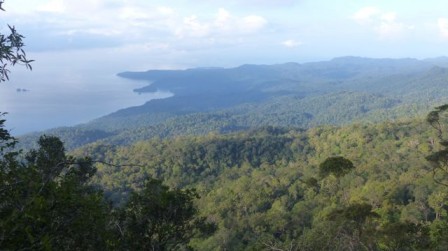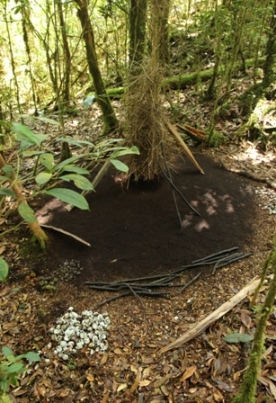Tuesday 18th November, from the camp in Kumawa.
The mountain summit explorers (Vincent, Christophe, Antoine and Philippe, accompanied by Olivier) came back yesterday from their treck. The climb and the descent were very tough. Only Vincent and his guide, Deman, managed to reach the top at 1,425 meters, because it was so steep. The researchers and the guides had to make their way up steep slopes, and over crumbly and unstable rocks. They crossed screes and had to mountain climb in some places. They first set up camp at 400 meters near a waterpoint, then the second at 1,150 meters the next day. Fortunately, they found water at 800 meters, which allowed them to refuel without having to climb down to the first camp.
The goal of this expedition was to reach the cloud forests above 1,000 meters, where the fauna and flora are very unusual. At this altitude, clouds gather against the slopes and the air is constantly heavy with humidity. It is cold at night and fresh during the day. The trees are small and covered in moss and ferns. Each summit is like a biodiverse mini island, isolated from the others by zones at a lower altitude. Populations of species living only in high-altitude environments found themselves isolated on these mini islands when the mountain range formed 2 to 3 million years ago. They evolved separately from the other populations which occupy other mountain ranges, sometimes giving birth to new species.
So far, only one scientist had climbed to the top of Mount Kumawa 30 years ago. It was Jared Diamond, Pulitzer-Prize winner and the author of many recent anthropology books, such as ‘’Collapse‘’ and “The World Until Yesterday”, which had a considerable impact. He is also a renowned expert on birds of New Guinea. During his exploration of the Kumawa summit, he discovered eight populations of new birds presenting features that he had never observed elsewhere. Unfortunatly, he could not take any pictures because his camera was jammed. He hypothesized that they may be new species. Christophe and Borja were dreaming of following his tracks so as to take pictures of these birds and collect blood samples to carry out genetic analyses. They eventually did it! Even if they did not reach the highest point, Vincent did it forgetting his orchids for a while to take pictures of a bowerbird’s bower. The bower is a circular wooing area of almost 2 meters in diameter used by the male to attract females. The bowers built by the Kumawa bowerbirds are some of the most spectacular that can be seen in New Guinea.
At 6 pm, representatives from each group boarded the Airaha 2 to participate in a videoconference with the Mare Nostrum aquarium in Montpellier. There, about a hundred primary school students from Montpellier participating in the expedition’s educational project were waiting for the connection to go live. They were able to ask scientists questions about the routine of their daily life on the field, and about the specificity of the scientific approaches used in each discipline.

Laurent and Régis on air with students at the Mare Nostrum aquarium in Montpellier – Copyright : S. Quérouil / IRD
(translated by Adeline Clutier, François Kresno-Pandoyo and Marylou Tournayre, L2 ST—Earth Sciences–UM2, France)




